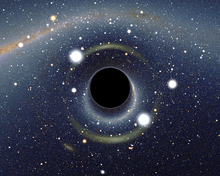No edit summary Tag: Visual edit |
No edit summary Tag: Visual edit |
||
| Line 4: | Line 4: | ||
Black holes are often seen as the remnants of [[Giant star|giant]] [[star|stars]] after they go supernova; if their iron cores are massive enough, they will collapse to form black holes. Black holes have a black spherical event horizon whose radius is directly proportionate to their mass (doubling a black hole's mass will double the radius), and a singularity of zero volume in the center. |
Black holes are often seen as the remnants of [[Giant star|giant]] [[star|stars]] after they go supernova; if their iron cores are massive enough, they will collapse to form black holes. Black holes have a black spherical event horizon whose radius is directly proportionate to their mass (doubling a black hole's mass will double the radius), and a singularity of zero volume in the center. |
||
| − | Objects that are pulled towards a black hole by its gravity will be taken within the event horizon - from their own perspective, if they survived, they would seem to simply fall in, but viewed from outside they would stop at the edge and become progressively more [ |
+ | Objects that are pulled towards a black hole by its gravity will be taken within the event horizon - from their own perspective, if they survived, they would seem to simply fall in, but viewed from outside they would stop at the edge and become progressively more [http://verse-and-dimensions.wikia.com/wiki/Redshift red-shifted] as their light is stretched out of visibility. Once inside the event horizon - or, for particularly small black holes, starting outside it - they would also be stretched out as the forces pull them apart unevenly in a process known as spaghettification. |
Some people believe that some or all black holes are actually [[Wormhole|wormholes]], and that each black hole maps to some exit point elsewhere in spacetime, possibly in the form of a [[white hole]] (a theoretical object which is the counter part of a black hole), or in entirely different [[universe|universes]]. These wormholes might function as [[portal|portals]], albeit dangerous and non-reprogrammable ones.{{StellarClassNav}} |
Some people believe that some or all black holes are actually [[Wormhole|wormholes]], and that each black hole maps to some exit point elsewhere in spacetime, possibly in the form of a [[white hole]] (a theoretical object which is the counter part of a black hole), or in entirely different [[universe|universes]]. These wormholes might function as [[portal|portals]], albeit dangerous and non-reprogrammable ones.{{StellarClassNav}} |
||
Revision as of 01:00, 15 April 2018

A black hole is a region of space with such strong gravity that its escape velocity exceeds the speed of light; thus, it appears black from the outside, as photons are pulled in and trapped.
Information
Black holes are often seen as the remnants of giant stars after they go supernova; if their iron cores are massive enough, they will collapse to form black holes. Black holes have a black spherical event horizon whose radius is directly proportionate to their mass (doubling a black hole's mass will double the radius), and a singularity of zero volume in the center.
Objects that are pulled towards a black hole by its gravity will be taken within the event horizon - from their own perspective, if they survived, they would seem to simply fall in, but viewed from outside they would stop at the edge and become progressively more red-shifted as their light is stretched out of visibility. Once inside the event horizon - or, for particularly small black holes, starting outside it - they would also be stretched out as the forces pull them apart unevenly in a process known as spaghettification.
Some people believe that some or all black holes are actually wormholes, and that each black hole maps to some exit point elsewhere in spacetime, possibly in the form of a white hole (a theoretical object which is the counter part of a black hole), or in entirely different universes. These wormholes might function as portals, albeit dangerous and non-reprogrammable ones.
| Stellar Classes |
|---|
| Main sequence classes: L · M · K · G · F · A · B · O
Brown dwarf classes: Y · T · L · M |
